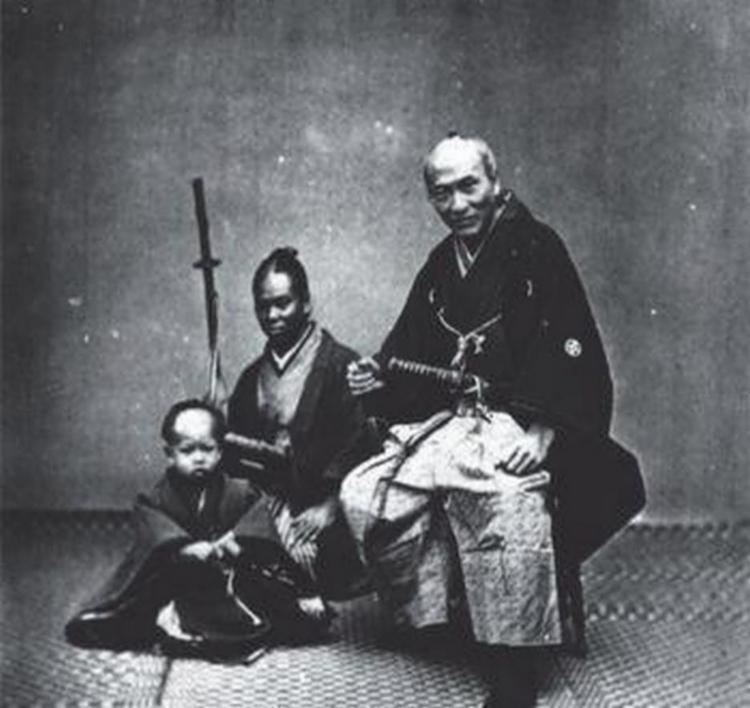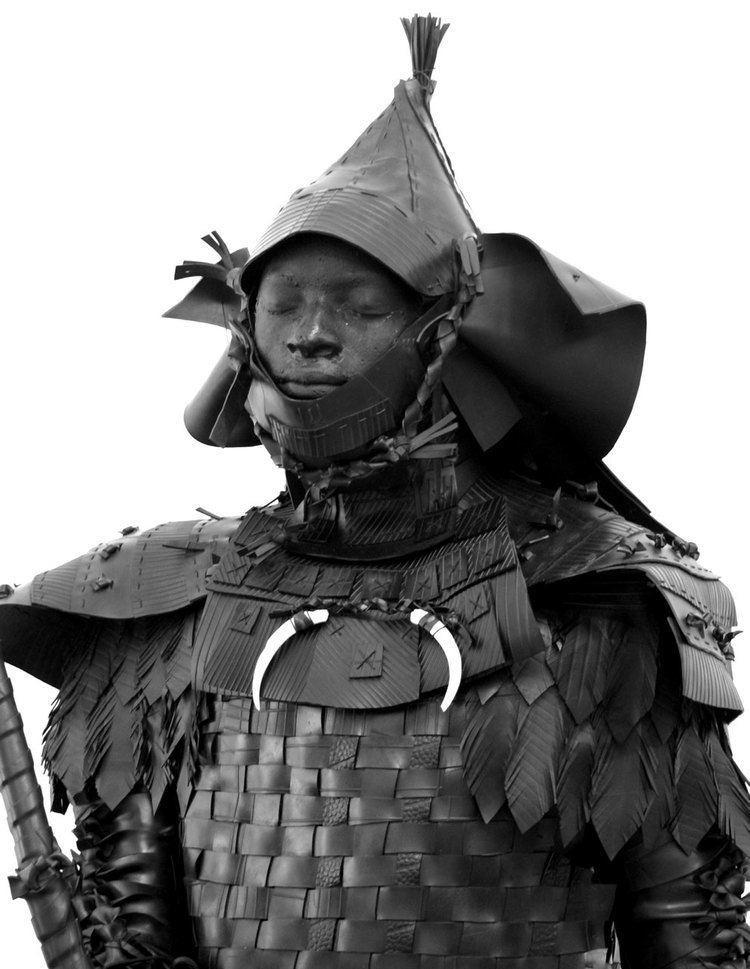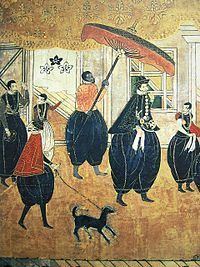 | ||
Similar | ||
The black samurai yasuke s tale the real afro samurai
Yasuke, (variously rendered as 弥助 or 弥介, 彌助 or 彌介 in different sources.) (b. c. 1555–1590) was a samurai of black African origin who served under the Japanese hegemon and warlord Oda Nobunaga in 1581 and 1582. The name "Yasuke" was granted to him by Nobunaga, although why and when is unclear. His original name is not recorded in any known source, so it is unclear if Yasuke is a Japanese rendering of his previous name, or a wholly new name granted by his lord.
Contents

Early life

According to Histoire Ecclesiastique Des Isles Et Royaumes Du Japon, written by François Solier of the Society of Jesus in 1627, Yasuke was likely from Portuguese Mozambique. Solier's account may however have been an assumption as it was written so long after the event and there is no surviving contemporary account that corroborates it. A 2013 investigation by the light entertainment television program Discovery of the World's Mysteries (世界ふしぎ発見) suggested that Yasuke was a Makua named Yasufe. This was not a highly journalistic investigation, and the program provided little proof for their conclusions and the Makua didn't have any significant conflict with the Portuguese based on the Island of Mozambique until 1585 .And furthermore, Makua, the agricultural people was not militant unlike Yasuke. He may have been a member of the Yao people, or other militant people from inland area of Mozambique. Yao people were just coming into contact with the Portuguese at the time, which might account for his name, Yao added to the common Japanese male name suffix of suke.

There is another theory that stated that Yasuke was Habshi from Ethiopia. Lockery Thomas argued that this theory is most convincing. Like Yasuke, Habshi was called "Cafre" by Portuguese, well‐built and skilled soldier unlike other east African that was suffering from famine. In this theory his original name might be Ethiopian Yisake or Portuguese Isaque, derived from Isaac.
In Japan
Yasuke arrived in Japan in 1579 in the service of the Italian Jesuit Alessandro Valignano, who had been appointed the Visitor (inspector) of the Jesuit missions in the Indies, meaning East Africa, South and East Asia. He accompanied Valignano when the latter came to the capital area in March 1581 and caused something of a sensation. In one event, several people were crushed to death while clamouring to get a look at him, the Jesuits feared their church would be flattened but they managed to avert disaster. Nobunaga heard the noise from the temple where he was staying and expressed a desire to see him. Suspecting the black color of his skin to be black ink, Nobunaga had him strip from the waist up and made him scrub his skin. These events are recorded in a 1581 letter of the Jesuit Luís Fróis to Lourenço Mexia and in the 1582 Annual Report of the Jesuit Mission in Japan, also by Fróis. These were published in Cartas que os padres e irmãos da Companhia de Jesus escreverão dos reynos de Japão e China II, normally known simply as Cartas, in 1598. Satisfied that he was in fact black, Nobunaga seems to have taken an interest in him, and at some point, although when is not clear, he was either given (Japanese accounts indicate him presented to Nobunaga, although European accounts do not mention this) or allowed to enter Nobunaga's service.
The Lord Nobunaga Chronicle (信長公記 Shinchō Kōki) corroborates Fróis' account, and describes their meeting thus: "On the 23rd of the 2nd month [March 23, 1581], a black page (黒坊主 kuro-bōzu) came from the Christian countries. The man was healthy and good-looking with a good demeanour. Moreover, Nobunaga praised Yasuke's strength, describing it as that of ten normal men. Nobunaga's nephew gave him a sum of money at this first meeting.
In May, Yasuke went with Nobunaga to his castle at Azuchi and popular rumors said he might be ennobled. The diarist Matsudaira Ietada, described him as 6 shaku 2 sun (6 ft. 2 in., or 188 cm.). He was black, and his skin was like charcoal." If so, his tall stature would have been very imposing to the Japanese of the time, even to a tall man like Nobunaga. Matsudaira stated that he was named Yasuke.
It is likely that Yasuke could speak considerable Japanese, perhaps due to Valignano's efforts to ensure his missionaries adapted to the local culture better, because Nobunaga enjoyed talking with him (there is no indication that Nobunaga spoke Portuguese and it is unlikely that Yasuke would have been able to communicate in classical Chinese, the oriental lingua franca of the time). He seems to have become a close retainer, and was perhaps the only non-Japanese 'warrior' that Nobunaga had in his retinue, which could account for his rapid rise in favour and status. Yasuke was also mentioned in the prototype of Shinchōkōki owned by Sonkeikaku Bunko (尊経閣文庫), the archives of the Maeda Clan. According to this, Yasuke was given his own residence and a short, ceremonial katana by Nobunaga. Nobunaga also assigned him the duty of weapon bearer.
In June 1582, Nobunaga was attacked and forced to commit seppuku in Honnō-ji in Kyoto by the army of Akechi Mitsuhide. Yasuke was also there at the time and fought the Akechi forces. Immediately after Nobunaga's death, Yasuke went to the join Nobunaga's heir Oda Nobutada who was trying to rally the Oda forces at Nijō Castle. Yasuke fought alongside the Nobutada's forces for a long time but he eventually surrendered his sword to Akechi's men. They asked Akechi himself what to do with him. Akechi said that the black man was a beast and did not know anything, and furthermore, he was not Japanese, so they should not kill him but take him to the nanban-dera or nanban-ji (南蛮寺, literally the temple of the southern barbarians, how the Japanese referred to the Jesuit church). It is said that the reason why Akechi spoke in such a manner was a form of taking pity on him, i.e. giving a clear reason why not to kill him. Black people were not discriminated against in Japan at this time; they were even admired, for the Buddha was often portrayed in black in Japanese temples. However, perhaps Akechi also did not want to offend the Jesuits, needing all the friends he could get at this time of political turmoil. This was much to the relief of the Jesuits there who calmed him down and thanked God for his deliverance. There is no further written information about him after this although Fróis, in his History of Japan, does mention a black African gunner in the service of Arima Harunobu in 1584, shortly after Yasuke's time with Nobunaga. This is likely to be a different man however, and there were many Africans in the service of Japanese and European employers, as well as independently employed men, in Japan at this time.
Popular culture
Yasuke was featured in the children's historical fiction novel, Kuro-suke (くろ助) by Yoshio Kurusu (1916–2001) with illustrations by Genjirou Minoda, published in 1968. It features a highly fictionalized and sympathetic account of Yasuke's life in Japan under Nobunaga. It received the Japanese Association of Writers for Children Prize in 1969. He has also appeared in numerous movies and dramas about Nobunaga.
Yasuke is a featured character in the 2017 video game Nioh, from Koei Tecmo. He can be challenged to a duel and is a playable skin in-game. He serves as a bodyguard to the villain of the game, Edward Kelley, and merely seeks to see his lord Nobunaga revived. He fights alongside an Atlas bear Guardian Spirit.
In March 2017, it was announced that Lionsgate Films and Michael De Luca will produce a film based on Yasuke written by Gregory Widen.
